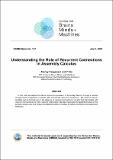| dc.contributor.author | Rangamani, Akshay | |
| dc.contributor.author | Xie, Yi | |
| dc.date.accessioned | 2022-07-06T20:10:50Z | |
| dc.date.available | 2022-07-06T20:10:50Z | |
| dc.date.issued | 2022-07-06 | |
| dc.identifier.uri | https://hdl.handle.net/1721.1/143618 | |
| dc.description.abstract | In this note, we explore the role of recurrent connections in Assembly Calculus through a number of experiments conducted on models with and without recurrent connections. We observe that as- semblies can be formed even in the absence of recurrent connections, but also find that models with recurrent connections are more robust to noisy inputs. We also investigate the spectral structure of the synaptic weights and find intriguing similarities between models of neural assemblies and associative memories. | en_US |
| dc.description.sponsorship | This material is based upon work supported by the Center for Brains, Minds and Machines (CBMM), funded by NSF STC award CCF-1231216. | en_US |
| dc.publisher | Center for Brains, Minds and Machines (CBMM) | en_US |
| dc.relation.ispartofseries | CBMM Memo;137 | |
| dc.title | Understanding the Role of Recurrent Connections in Assembly Calculus | en_US |
| dc.type | Article | en_US |
| dc.type | Technical Report | en_US |
| dc.type | Working Paper | en_US |
